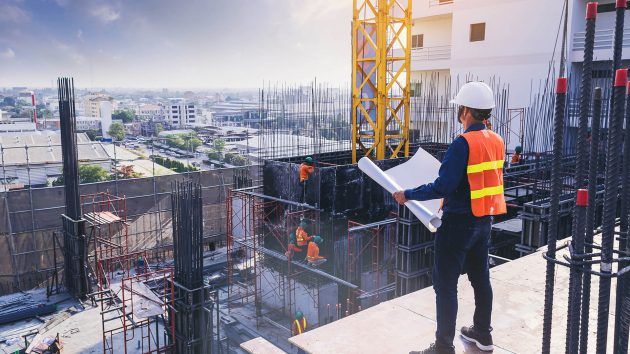Risk management is the systematic identification, assessment, and prioritization of risk with the goal of reducing risk. Risk management in the construction industry is the practice of identifying, assessing, controlling, and monitoring project risk throughout the life cycle of a project. Risks can either be internal or external. Internal factors include project team members, project subcontractors, materials, and environmental factors. External factors include client, government, and project financing.

Risk Management in Construction Projects
Construction projects can take months, years, and even decades to complete. The success of any construction project can hinge on proper risk management, which means mitigating the risks associated with the construction process. From weather to construction delays, there are a number of risks that threaten to derail your construction project. To mitigate those risks, however, you must have a risk management plan in place, and the hardest part of planning is knowing what risks are involved. The following are the types of risks that you may encounter during a construction project.
Safety risk
Today, one of the biggest challenges for any construction project is managing safety. Safety concerns are the responsibility of everyone who works on a construction project. Safety risks are something that everyone in a construction project should consider. Not every person in a construction project will be involved in every safety concern. Who is responsible? Everyone. By working safely, everyone in a construction project can be covered by insurance, which can work well for projects.
Also, projects of this magnitude should always be considered and used with tools that will lead to the success of the project and maintain the safety and security of all involved, such as underground utility maps that can prevent unexpected costs, infrastructure damage, safety issues and much more.
Financial risk
At the construction site, there are many risks that you may face. One of these risks regarding finances is the risk that you may encounter during construction projects. This happens when you are involved in any construction project and you are not able to handle the expenses involved. Financial risk occurs when you don’t have enough funds or you don’t have the resources to pay for costs associated with construction. But the financial risk is not the only risk that may occur in construction projects.
Legal risk
Legal risk is one of the risks that you may encounter during construction projects. In construction, there are many Legal Risks, and one of them is liabilities that can arise out of either inherent or defects in the construction work, which itself can lead to an accident or from the third party involved. And because of this huge Legal Risk, it is very important that construction Comp Management plans are in place so that any Legal Risk can be minimized, which makes the Construction Safety Software important.
Project risk
Construction projects are fun, exciting, and a bit overwhelming. Encountering new risks can lead to accidents, injuries, or even death. One risk that can be encountered in many construction projects is Project risk. It is characterized by uncertainty, unpredictability, and ambiguity. Project risk is inherent in construction processes and activities. It varies in magnitude and can occur at various phases of projects. Project risk impacts the project performance, schedule, and budget.
Environmental risk
Environmental risk is one of the risks that you may encounter during construction projects. Environmental risk is from nature and includes poor weather conditions, long working hours, and construction site-related accidents. Strong winds, storms, flooding, and low temperatures are just some of the environmental risk factors of construction work. For construction companies, environmental risk can be extremely dangerous.
Methods for Risk Management
Risk management describes a set of techniques you can use to identify, assess, and control the risks associated with your business. If you do not actively manage your risk, you may end up permanently damaging your business. To properly manage your risk, you must first identify what risks you are dealing with and then develop methods to control them.
Avoidance
Avoidance is one of the methods for risk management. Avoidance is “the practice of reducing risks by avoiding or removing the potential for harm.” Avoidance is rooted in the idea that you cannot eliminate all risks from your life. You can, however, mitigate or reduce the risks associated with certain situations to minimize their negative consequences—by, say, choosing not to drive when you’re drunk or by not carrying your credit cards around with you.
Retention
Retention is one of the methods for risk management and is utilized by organizations that maintain their records for more than seven years. Retention plans involve defining how long an organization will maintain certain records. Once retention periods are defined, retention plans outline the steps organizations will take to ensure that the retention period is met.
Sharing
Sharing is one of the methods for risk management. The purpose of risk management is to identify, analyze, and control the risks associated with the business. According to Wikipedia, risk management is: “the process of identifying, assessing, managing, and mitigating the risks involved in managing an enterprise, with the goal of reducing risks to create value.” Risks could result in loss of money, loss of resources, and inefficient use of resources. Sharing is one of the methods for risk management.
Transferring
Transferring is one of the methods for risk management. Risk management is a process that can be used to evaluate, measure, and manage risks that the organization faces. Risk management involves identifying, assessing, managing, and transferring risks. The first step includes identifying risks. Identifying and classifying risks is very important to risk management.
Loss prevention and reduction
Loss prevention and reduction are some of the methods for risk management. Loss prevention means preventing the loss of assets or money. On the other hand, reduction means reducing loss. Generally, the term Loss prevention is used to identify a method that reduces loss by preventing or controlling fraud, theft, or misuse of assets.
Conclusion
Construction management is a vital tool for project managers. The profession, which is responsible for agricultural, residential, commercial, and industrial projects and, in general, anything that’s built, is a high-paced industry that requires focused attention and strong communication skills. Whether supervising engineers, carpenters, or subcontractors, the project manager must be well versed in construction law, building codes, insurance, contracts, project management, human resources, accounting, business, and leadership.














